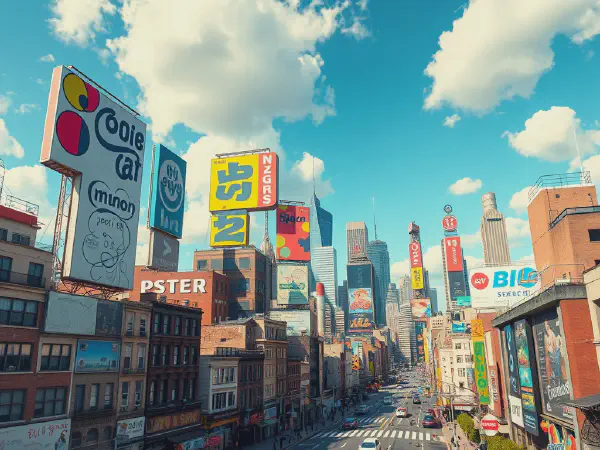Explore the World of Gigantic Signs: Art, Design, and Impact

Exploring the World of Gigantic Signs
Gigantic signs have become a staple in urban landscapes, capturing attention and conveying messages with their impressive scale and design. These colossal markers serve as beacons for businesses, attractions, and events, providing not only information but also visual allure. The sight of gigantic signs can evoke feelings of wonder and curiosity, making them a significant part of modern architecture and advertising.
The significance of gigantic signs extends beyond mere aesthetics. They play a crucial role in marketing strategies, providing brands with an opportunity to stand out in a crowded marketplace. Via vibrant colors, LED displays, and creative designs, gigantic signs ensure that companies enhance their visibility and recognition, creating impactful connections with potential customers.
In addition to their advertising potential, gigantic signs often become iconic landmarks in their own right. They represent the culture, history, and identity of their locations. Whether it's the famous 'Hollywood' sign in Los Angeles or the gigantic digital billboards of Times Square, these signs serve as symbols that enhance the character of a city and draw visitors from around the globe.
The artistic expression involved in creating gigantic signs cannot be overlooked. Signage has transitioned into an art form, with artists and designers pushing the boundaries of creativity. Utilizing innovative materials and technology, artists create engaging visuals that tell stories or provoke thought, capturing the imagination of onlookers.
Ultimately, gigantic signs represent a fusion of art, engineering, and commerce. The world of gigantic signs continues to evolve, adapting to technological advancements and shifts in consumer behavior, making them an intriguing subject for exploration in our contemporary society.
Advertising with Gigantic Signs
Gigantic signs are a powerful tool for advertisers, offering maximum exposure in busy urban environments. Their size and visibility ensure that messages reach large audiences, making them a popular choice among brands aiming to make a memorable impact. Statistics have shown that consumers are more likely to recall brands associated with striking visuals, affirming the strength of gigantic signs in marketing.
Around the world, many iconic gigantic signs have become landmarks, serving as symbols of their respective cities. The 'Welcome to Fabulous Las Vegas' sign and the London Eye’s towering advertisements are just a few examples of how commercial signage can blend with tourism, drawing millions of visitors each year. These signs not only advertise but also contribute to the local economy and culture.
When designing impactful advertising signs, certain tips can elevate effectiveness. High contrast colors, unique typography, and intriguing graphics can captivate viewers' attention. Additionally, it's essential to consider the environment where the sign will be placed, ensuring it complements or enhances its surroundings while remaining legible from a distance.
Artistic Expression in Gigantic Signs
Various artists around the globe are known for their contributions to the art of gigantic signs. From installation artists to muralists, these creative individuals utilize large-scale signage as a canvas to express their visions. Notable examples include the works of artists like Shepard Fairey, whose bold designs promote social messages across urban landscapes.
The cultural significance of large-scale signage is profound, often tied to local traditions and values. Gigantic signs can represent the community's identity, showcasing local art or historic events. As public art installations, they invite dialogue and reflection, bridging gaps between art, culture, and commerce.
Sign art has evolved dramatically in urban spaces. Historically seen as mere advertisement tools, they now incorporate artistic elements, merging technology and creativity. Modern sign art features neon lights, video displays, and interactive components, contributing to the evolution of city aesthetics and public engagement with art.
Engineering and Construction of Gigantic Signs
Creating gigantic signs involves the use of various materials designed for durability and visibility. Steel, aluminum, and specialized plastics are common, offering resilience against weather conditions. Illuminated signs typically incorporate LED technology, providing energy efficiency while being bright enough to catch attention, even at night.
Constructing gigantic signs comes with a unique set of challenges. Engineers must consider factors such as wind resistance, structural integrity, and local zoning laws. The logistics of installing such large structures can be complex, requiring detailed planning and coordination with multiple stakeholders to ensure compliance and safety.
Safety standards for gigantic signage installations are crucial to protect both the public and the environment. These standards often include regulations on height, visibility, and material usage, ensuring that signs are not only visually appealing but also safe and secure in their locations.
Digital Technologies in Gigantic Signs
The rise of digital technologies has transformed the landscape of gigantic signage. LED displays allow for dynamic content that can be easily updated, promoting versatility in advertising and communication. Digital gigantic signs can showcase multiple messages throughout the day, maximizing exposure and reaching diverse audiences.
Modern gigantic signs often incorporate interactive features, such as QR codes or augmented reality. These enhancements invite passersby to engage with the signs beyond mere observation, allowing for immersive experiences that enhance brand interaction and encourage consumer participation.
Looking ahead, future trends in digital gigantic signs promise exciting advancements. Innovations in hologram technology, 3D displays, and AI-driven content are on the horizon, potentially creating even more compelling signage experiences. As technology advances, so will the creative possibilities for brands looking to leverage gigantic signs for maximum impact.
Gigantic Signs in Popular Culture
Gigantic signs often hold a prominent place in popular culture, frequently appearing in movies as symbols of status, hope, or dreams. They serve as backdrops for memorable scenes, instantly recognizable by audiences and contributing to the film's emotional resonance. Films like 'Lost in Translation' highlight the grandeur of city life through their portrayal of iconic signage.
In music videos, gigantic signs convey dynamism and energy, enhancing the visual narrative. Artists often feature prominent signs to establish themes related to urban life, success, or aspiration. These visuals complement the song's message and enhance audience engagement, creating a memorable experience.
Literature also references gigantic signs to reflect societal values or personal journeys. Authors use these symbols to represent human aspirations and the quest for identity. Whether as a metaphor for success or a landmark in a character’s journey, gigantic signs resonate deeply within narratives, offering layers of meaning.
